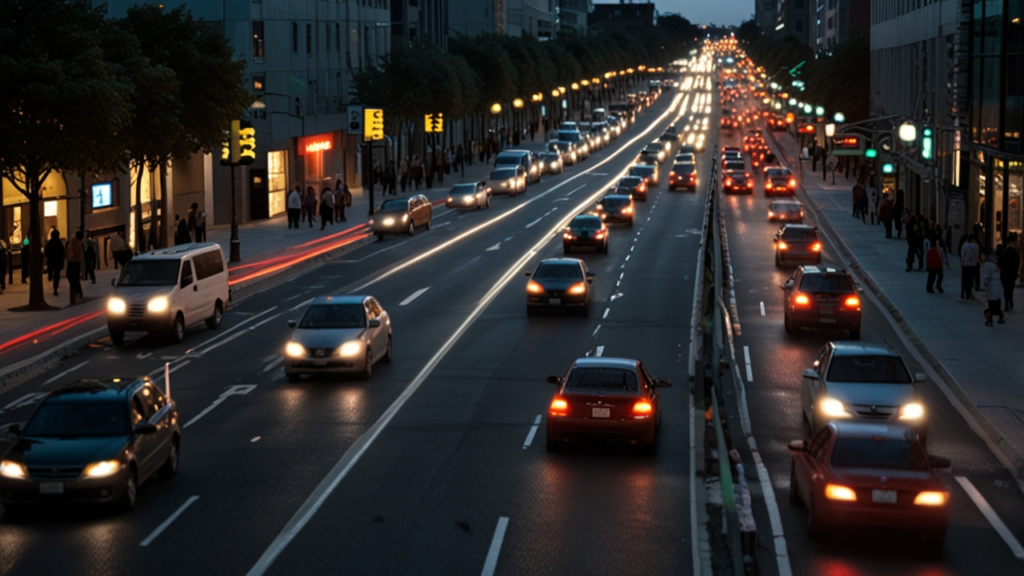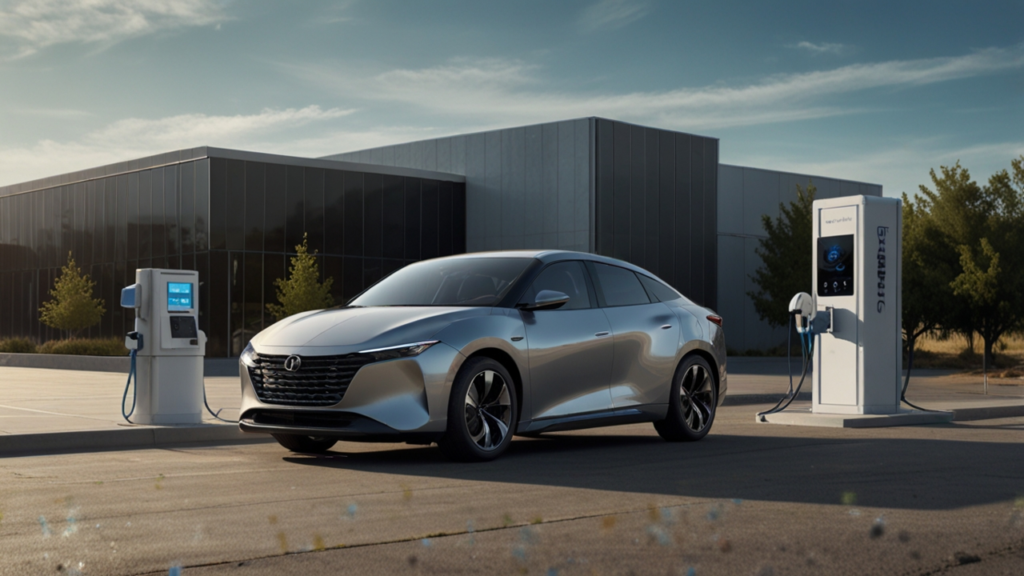Smart Traffic Systems: 7 Intelligent Solutions
Smart Traffic Systems have revolutionized how we navigate our cities and suburbs. By integrating cutting-edge technology with everyday infrastructure, these systems significantly improve how traffic flows and reduce delays. Their impact is evident across multiple continents and in various urban settings.
Today’s traffic control is far beyond the manual regulation of the past. Modern sensors, artificial intelligence, and real-time data collection allow cities to dynamically adjust to the constantly changing demands on their road networks. This progress fosters a safer and more efficient driving experience for everyone.
In this article, we will explore the evolution, methodologies, and future predictions for Smart Traffic Systems. With clear explanations and engaging examples, we invite you to discover how these innovations transform urban life. Have you ever wondered what goes on behind the scenes every time your traffic light changes?
Table of Contents
- Introduction to Smart Traffic Systems
- Evolution and History of Smart Traffic Systems
- How Urban Mobility Enhances Smart Traffic Systems
- AI Optimization in Smart Traffic Systems
- Real-World Case Studies of Smart Traffic Systems
- Real-Time Monitoring in Modern Smart Traffic Systems Solutions
- Future Trends in Smart Traffic Systems: Flow Management and Beyond
Introduction to Smart Traffic Systems Smart Mobility
Overview and Significance
Smart Traffic Systems integrate technology and infrastructure to control the flow of vehicles across urban landscapes. They rely on sensors, AI algorithms, and data collected in real time to optimize signal timings and improve safety. This modern approach replaces older, manually coordinated efforts and has proven beneficial in reducing congestion and idling times.
For instance, early traffic signals, which first appeared in 1868 in London as gas-lit semaphores, have evolved significantly. By the 1910s, electric signals became popular in the U.S., and since then, these systems have integrated advanced vehicle detection and AI automation. Detailed insights about the historical progress can be found in a comprehensive ITS program study.
Engineers and city planners use Smart Traffic Systems to dynamically control traffic based on actual demand. In scenarios where traffic congestion peaks unexpectedly, these systems adapt to ensure vehicles are serviced quickly. Have you considered how such adaptability could reshape your daily commute?
Core Technologies and Components
At the heart of Smart Traffic Systems are sensors and edge computing devices that track vehicle counts, speeds, and queue lengths. These systems employ advanced methods like adaptive signal timing to change traffic light patterns in response to evolving traffic conditions.
The integration of tools such as radar, video cameras, and infrared sensors create a multi-modal monitoring network that improves response times and overall traffic flow. Resources like the detailed analysis on dynamic timing details illustrate how these components work together seamlessly.
Moreover, the interplay between data collection nodes and centralized processing units ensures that the system can predict and manage demand effectively. Next, consider how you might experience a smoother trip if such technology were broadly implemented in your city.
Evolution and History of Smart Traffic Systems Urban Transportation
From Manual Control to Automated Systems
Traffic control has come a long way from manual policing and fixed-time signals. Early systems required human intervention and set schedules that could not adjust to real-time changes. This method often led to delays, especially under unexpected traffic spikes.
The breakthrough came when automated sensors were introduced in the 1970s-80s, allowing signals to change based on vehicle detection. According to traffic light evolution details, this transition reduced waiting times and queues significantly, paving the way for modern adaptive methods.
Have you ever thought about how these simple changes led to the complex networks we see today?
The Emergence of Intelligent Transportation Systems (ITS)
The integration of communication technologies into traffic control ushered in the era of Intelligent Transportation Systems (ITS). Expanding in the 1990s through the 2010s, ITS combined real-time data, signal coordination, and emergency vehicle prioritization to create efficient urban mobility networks.
This systematic approach was supported by agencies such as the U.S. DOT’s ITS Joint Program Office. Documents like the study on ITS can be verified via ITS program study, which highlights its evolution from fixed plans to intelligent, adaptive solutions.
What benefits do you see arising from the gradual adoption of these innovative practices?
How Urban Mobility Enhances Smart Traffic Systems Smart Cities
Integration with Public Transportation
Urban mobility is redefined when traffic systems help integrate multiple modes of transport. Cities are implementing priority systems for emergency vehicles and public transit. For example, transit signal priority extends green phases for buses to ensure timely travel.
This coordination results in smoother transit operations and lower congestion overall. As urban areas evolve into smart cities, even pedestrian safety is enhanced by the addition of detection systems that adjust signal phases.
Have you experienced improved public transportation service due to integrated signal systems?
Impact on Road Safety and Efficiency
By adaptively regulating traffic, Smart Traffic Systems help minimize accidents at intersections. The synchronized operation of signals reduces the potential conflicts between vehicles, pedestrians, and cyclists.
A study on road safety improvements confirms that reduced stops and smoother flows lower the risk of collisions. Such systems are integral to urban planning strategies that prioritize safety and drive down operational costs.
Do you think an integrated approach to traffic control could lead to safer urban streets?
AI Optimization in Smart Traffic Systems Digital Transformation
Machine Learning and Predictive Modeling
Machine learning now plays a crucial role by predicting short-term traffic patterns based on historical and real-time data. With accurate predictive models, traffic signals adjust before congestion becomes critical.
Such systems leverage data points from cell networks and connected fleets to forecast travel demand. Insights from sensor-based history provide a deep understanding of the transformation from static timings to dynamic responsiveness.
Is it possible that the future of travel depends on how well these predictive tools are implemented?
Adaptive Signal Timing and Its Effectiveness
Adaptive signal timing is a core methodology that adjusts cycle lengths and green splits on the fly. Based on real-time sensor input, these timings are refined to ensure minimal stoppage and optimal flow.
The benefits of this approach are clear: reduced travel times, lower emissions due to fewer starts and stops, and enhanced safety at intersections. Resources such as roadways revolution discuss the incredible impact of these technologies on urban infrastructure.
Do you believe that AI can completely eliminate traffic jams if applied universally?
Real-World Case Studies of Smart Traffic Systems Future Transport Solutions
Case Study: Smart Columbus
Smart Columbus in Ohio stands out as a prime example of integrated traffic management. The city deployed Signal Phase and Timing (SPaT), Emergency Vehicle Preemption (EVP), and Transit Signal Priority (TSP) to create a seamless mobility ecosystem.
Through these measures, over 42,000 parking spaces were managed and citywide applications improved emergency response times. Information from various industry sources shows that Smart Columbus has significantly cut wait times and travel delays.
Can you imagine a city where every vehicle operates in near-perfect harmony through such sophisticated systems?
Comparison of Global Deployments
Across North America, Europe, Asia, and Australia, cities are adopting Smart Traffic Systems to address unique regional challenges. In the U.S., programs like Smart Columbus set the benchmark, while European cities such as Stockholm deploy IoT-enabled detection systems to reduce travel times and enhance efficiency.
In Asia, countries like Japan and South Korea lead with advanced signal coordination and V2X solutions. Australian road agencies focus on reliability and safety with coordinated adaptive network trials.
How might your region benefit if similar technologies were adopted locally?
Comprehensive Comparison of Case Studies
| Example | Deployment Region | Key Features | Impact |
|---|---|---|---|
| Smart Columbus | North America | SPaT, EVP, TSP, multimodal planning | Reduced delays, improved response |
| Stockholm | Europe | IoT-enabled detection, adaptive signal timing | Shorter travel times, efficiency gains |
| Tokyo Corridor | Asia | Advanced V2X, bus priority, pedestrian safety | Smoother flow, enhanced safety |
| Sydney Trials | Australia | Coordinated adaptive networks, connected intersections | Increased reliability, efficient freight routes |
| San Francisco Pilot | North America | Real-time data sharing, predictive modeling | Fewer stops, reduced congestion |
Real-Time Monitoring in Modern Smart Traffic Systems Solutions
Technologies Enabling Real-Time Adjustments
Real-time monitoring forms the backbone of smart traffic signal adjustments. Sensors continuously collect data on speed, queue lengths, and vehicle counts to ensure timely signal modifications. This data feeds directly into central and edge analytics systems that determine the most efficient timing plans.
Advancements from sources on dynamic timing details highlight how quickly and effectively these systems react to fluctuations in traffic. In many cities, this approach leads to smoother flow and reduced environmental impact.
How would your commute change if traffic signals adapted instantly to surge traffic in real time?
Data Integration and Privacy Considerations
Integrating data from multiple sources – including video, radar, and mobile probe data – is essential for effective real-time monitoring. These diverse data streams merge into algorithms that optimize traffic missions every few seconds. Authorities must also consider privacy, carefully balancing surveillance needs with citizens’ data protection rights.
Studies are generally accepted to confirm that if managed well, privacy concerns can be mitigated without losing the efficiency gains of real-time systems. Research on urban sensor networks supports this balance.
What steps do you think can be taken to ensure data privacy while still benefiting from continuous traffic monitoring?
Future Trends in Smart Traffic Systems: Flow Management and Beyond
Emerging Technologies and AI-Driven Innovations
Looking forward, the integration of AI continues to evolve and offers exciting prospects. Future trends emphasize AI-first adaptive control and the scale-up of vehicle-to-infrastructure communication. These systems not only predict traffic flow, they manage emissions by incorporating environmental monitoring.
Industry experts predict that reinforcement learning methods at both edge and cloud levels will further refine control algorithms. Information from roadways revolution confirms that such AI-driven approaches will soon become commonplace. The transformation could be radical and provide unparalleled flow management efficiency.
How might future innovations transform the way our cities manage traffic and environmental impact?
Integration and Sustainability Challenges
While the benefits of these future technologies are promising, several challenges persist. Legacy infrastructure and cost constraints often slow down the integration of cutting-edge solutions in established urban environments. City planners must work gradually to modernize these networks without sacrificing current efficiencies.
Sustainable development and fairness in the distribution of benefits remain key issues. For example, equitably addressing which neighborhoods receive priority investments is a question both engineers and policymakers must confront. Have you ever considered how these challenges might be overcome in your city?
Efforts towards sustainability not only enhance traffic flow but also contribute to cleaner urban air and lower carbon footprints. Continuous dialogue between technologists and policymakers is essential to address these complex issues.
Smart Traffic Systems Spotlight: A Fresh Perspective
This section presents an alternate view of modern traffic control without relying on specialized terminology. Imagine a system where everyday navigation becomes as intuitive as following a gentle stream. The roads gently guide you and adapt to unforeseen circumstances, offering an environment that feels both safe and reassuring. Users notice a rhythm in their everyday journeys that seamlessly adjusts to sudden changes and varying patterns. The experience is both comforting and innovative, leading to a striking reduction in unexpected delays.
This transformation fosters a dynamic community where movement is smooth and interruptions are rare. Fresh strategies drive the evolution from rigid schedules towards responsive pathways. As communities begin to experience these soft transitions, the urban landscape gradually evolves into one with a relaxed yet efficient cadence. By embracing a holistic approach, newly designed pathways unite diverse travel elements in a single orchestrated flow. Witnessing such harmony in an urban setting brings hope and sparks ideas for future enhancements. The promise of a fluid, adaptable journey offers a new gateway to reimagined mobility, empowering each individual to look forward to hassle-free travel with optimism and enthusiasm.
This forward-thinking approach challenges traditional norms and paves the way for a transformation that redefines possibilities. The future beckons with clarity, as innovations set the stage for a refined experience. Such breakthroughs evoke a sense of wonder and motivate society to dream big about what tomorrow may hold.
FAQ
What are Smart Traffic Systems?
They are advanced traffic management systems that use sensors, artificial intelligence, and real-time data to optimize vehicle flow, reduce congestion, and enhance safety in urban areas.
How did these systems evolve over time?
The evolution started from manual traffic signals, transitioning to fixed-timed signals, then to sensor-actuated systems, and finally to modern adaptive systems integrated with AI and real-time data processing.
Can Smart Traffic Systems improve urban safety?
Yes, by reducing stop-and-go driving and managing collisions through adaptive signal timing and emergency vehicle prioritization, these systems significantly improve road safety.
What role does real-time monitoring play?
Real-time monitoring ensures that traffic signals adapt quickly to current conditions by processing continuous data inputs, leading to smoother traffic flow and minimized congestion.
What future trends are expected in these systems?
Future trends include the expansion of AI-driven predictive models, increased vehicle-to-infrastructure communication, and more sustainable and integrated urban mobility solutions.
Conclusion
The journey through the evolution and application of Smart Traffic Systems reveals a fascinating merger of tradition and innovation. We have seen the transformation from early signal control to advanced, AI-driven networks that manage daily urban mobility with unprecedented precision.
These systems continue to evolve, driven by careful planning and technological enhancements. As you travel through your city, notice how smoother flows reduce delays and make your commute less stressful. For more information, explore additional resources or Contact us with your thoughts. Have you experienced similar improvements in your area, and what changes would you like to see next?
To further explore groundbreaking developments, check out our insights on Future Mobility and join the conversation about how unfolding innovations can shape tomorrow’s urban landscapes.



